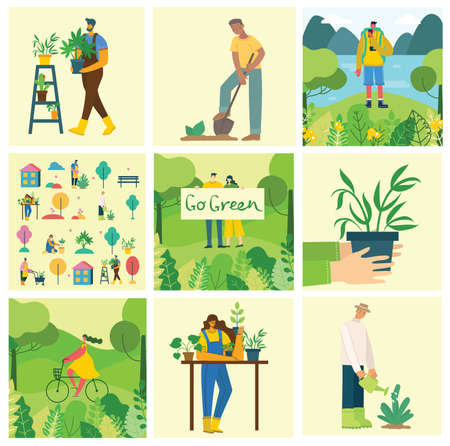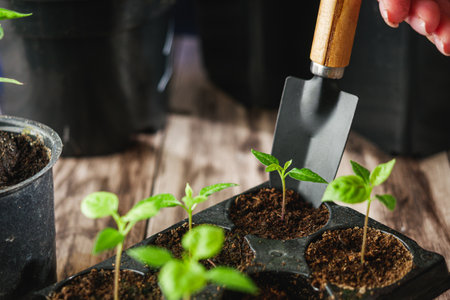1. Understanding Microclimates
When we talk about creating thriving gardens using permaculture principles, one of the most powerful tools in our toolbox is understanding microclimates. A microclimate is a small area that has different temperature, light, moisture, or wind conditions than the surrounding environment. These differences can be natural or created by human design, and they play a big role in how well your plants grow.
What Is a Microclimate?
A microclimate is exactly what it sounds like—a “mini climate” within a larger one. You might notice that one side of your yard gets more sun, while another stays cooler and damp. That’s a basic example of a microclimate. These variations can be caused by things like buildings, fences, trees, slopes, water features, or even soil types.
Natural Occurrence of Microclimates
Microclimates naturally occur all around us. For example, in the U.S., you’ll find cool shady forests in the Pacific Northwest and hot dry deserts in the Southwest. But even within a single backyard in New York or Texas, different areas will have their own unique conditions based on sunlight exposure, elevation changes, and nearby structures.
Common Factors That Create Microclimates:
| Factor | Description |
|---|---|
| Sunlight | The amount of direct sun an area receives throughout the day. |
| Wind | Sheltered spots can be warmer and less dry than open windy areas. |
| Moisture | Low-lying areas may collect more water; raised beds may dry out faster. |
| Slope and Elevation | South-facing slopes get more sun (in the Northern Hemisphere), making them warmer. |
| Structures | Walls and fences block wind and reflect heat, creating warmer zones. |
| Trees and Vegetation | Trees provide shade and reduce evaporation, cooling nearby soil and air. |
Why Microclimates Matter in Permaculture
Permaculture focuses on working with nature rather than against it. By observing and using existing microclimates—or designing new ones—you can create spaces where plants thrive with less effort and fewer resources. For example, placing heat-loving tomatoes near a south-facing wall can extend their growing season in cooler climates like Colorado or Minnesota.
Sustainable Gardening Across American Climates
The United States includes a wide range of USDA Hardiness Zones—from chilly Alaska to tropical Florida. Understanding microclimates helps gardeners across these zones tailor their plant choices and garden designs accordingly. Whether youre dealing with dry winds in Arizona or coastal fog in California, recognizing your unique microclimate allows for smarter planning and better yields.
A Few Real-Life Examples:
- Northeast: Use stone walls to trap heat for early-spring planting.
- Southeast: Plant under tree canopies to reduce heat stress during hot summers.
- Midwest: Build windbreaks to protect sensitive crops from strong gusts.
- Pacific Northwest: Choose raised beds to help with drainage in rainy seasons.
- Southwest: Create shaded microclimates using trellises or native shrubs to conserve water.
This foundational understanding of microclimates sets the stage for smart design strategies as we explore how permaculture principles guide us in shaping these environments purposefully.
2. Core Permaculture Principles for Climate Design
When designing microclimates using permaculture, it all starts with understanding a few key principles. These foundational ideas help guide how we interact with our space and how we can work with nature to create comfortable, productive environments. Let’s take a closer look at some of the most important ones.
Observe and Interact
This principle reminds us to slow down and pay attention to what’s already happening in our environment. Before making any changes, spend time watching how sunlight moves across your yard, where the wind comes from, and which areas stay moist or dry. The more you observe, the better decisions you can make about where to plant trees, build structures, or add water features that influence microclimates.
Use Edges and Value the Marginal
Edges—where two different environments meet—are often the most diverse and productive parts of a landscape. Think of the border between a forest and an open field or the edge of a pond. In your garden, you can create these beneficial edges by adding curved garden beds, planting along fences, or using stepping stones surrounded by herbs and low-growing plants. These areas tend to have unique conditions that support a wider variety of life.
Integrate Rather Than Segregate
Nature works best when elements are connected and support each other. Instead of separating everything—like keeping vegetables in one spot and pollinator flowers far away—try mixing them together. For example, planting shade-loving greens under taller crops or placing a compost pile near fruit trees can help share resources like nutrients and moisture while creating small pockets of favorable climate.
Examples of How These Principles Support Microclimate Creation
| PDC Principle | Microclimate Strategy | Real-World Example |
|---|---|---|
| Observe and Interact | Track sun & wind patterns before planting | Planting heat-loving tomatoes on the south-facing wall |
| Use Edges & Value the Marginal | Create layered planting zones along fences or walls | Growing herbs along a stone path that retains warmth at night |
| Integrate Rather Than Segregate | Combine plantings to create shade & moisture retention | Placing lettuce under corn stalks for cooler growing conditions |
Putting It Into Practice
The beauty of permaculture is that it encourages working with nature instead of against it. By observing whats already happening in your space, designing around natural edges, and integrating elements thoughtfully, you can begin shaping microclimates that support healthy plants, reduce labor, and even improve comfort for people spending time outdoors.

3. Designing with Topography and Water
One of the most powerful ways to create beneficial microclimates in your landscape is by working with the natural shape of the land—its topography—and incorporating water wisely. Whether youre dealing with a backyard garden or a larger homestead, understanding how slopes, swales, and water features influence temperature and moisture can help you build more resilient and productive systems.
Understanding Your Land’s Slope
Slopes affect how sunlight hits your land, how air moves across it, and how water flows through it. South-facing slopes in the U.S. typically receive more sun, making them warmer and ideal for growing heat-loving plants. North-facing slopes stay cooler and are great for shade-tolerant species.
Sunlight Exposure Based on Slope Direction
| Slope Direction | Sun Exposure | Ideal Use |
|---|---|---|
| South-facing | High sun exposure | Warm-season crops like tomatoes, peppers |
| North-facing | Low sun exposure | Cool-weather crops, woodland plants |
| East-facing | Morning sun, afternoon shade | Leafy greens, herbs that prefer cooler afternoons |
| West-facing | Afternoon sun (hotter) | Drought-tolerant plants like lavender or rosemary |
Using Swales to Capture Water
Swales are shallow trenches dug along the contour lines of a slope. They slow down rainwater runoff, allowing it to soak into the ground instead of washing away precious topsoil. This not only conserves water but also creates moist microclimates that benefit nearby plants.
Benefits of Swales:
- Increases soil moisture retention
- Reduces erosion on slopes
- Nourishes trees and perennials planted below the swale line
- Encourages biodiversity by supporting a variety of plant types
Add Water Features for Temperature Regulation
Ponds, small streams, or even birdbaths can help stabilize temperature swings in your garden. Water absorbs heat during the day and slowly releases it at night, creating a buffering effect that protects plants from extreme temperatures.
Simple Water Features That Support Microclimates:
| Feature | Main Benefit |
|---|---|
| Pond | Cools surrounding area in summer; retains warmth at night; attracts beneficial wildlife |
| Bioswale or Rain Garden | Catches stormwater and reduces runoff; supports native wetland plants |
| Drip Irrigation Basin | Keeps root zones hydrated efficiently; minimizes evaporation loss |
| Misting System (for greenhouses) | Lowers air temperature; increases humidity for sensitive plants |
The Permaculture Approach: Work With Nature, Not Against It
The key to success lies in observing your landscape and designing elements that complement its natural flow. Instead of fighting gravity or forcing water where it doesn’t want to go, permaculture teaches us to harness these forces to our advantage. When topography and water are used thoughtfully, they become allies in creating healthy microclimates that support diverse plant life while conserving resources.
4. Using Plants and Structures to Influence Microclimates
One of the most powerful ways to shape microclimates in your garden is by using plants and structures strategically. In permaculture design, we work with nature to create comfortable, productive environments for both people and plants. By placing trees, shrubs, windbreaks, shade structures, and soil cover thoughtfully, you can create areas that retain moisture, block harsh winds, and capture warmth from the sun.
Trees and Shrubs as Natural Climate Tools
Trees and shrubs are more than just pretty landscape features—they act as living tools for managing light, wind, and water. Deciduous trees provide shade in summer while allowing sunlight through in winter. Evergreen shrubs can serve as year-round windbreaks or privacy screens.
| Plant Type | Main Function | Best Placement |
|---|---|---|
| Deciduous Trees (e.g., Maple, Oak) | Summer shade, Winter sun access | South or west side of homes/gardens |
| Evergreen Shrubs (e.g., Juniper, Boxwood) | Wind protection, year-round barrier | North or prevailing wind side |
| Fruit Trees (e.g., Apple, Peach) | Shade + food production | Grouped near patios or walkways |
Creating Windbreaks for Protection
Windbreaks reduce the speed of cold or drying winds that can damage plants and erode soil. A good windbreak is dense enough to slow wind but still allows some airflow to prevent turbulence. Use layers: tall trees in back, medium shrubs in the middle, and low groundcovers in front.
Tips for Effective Windbreaks:
- Use a mix of species for resilience against pests and disease.
- Plant windbreaks perpendicular to prevailing winds (often from the north or northwest in the U.S.).
- Aim for a height that will protect an area up to 10 times the height of the tallest plant.
Designing Sun Traps for Warmth
Sun traps are areas designed to collect and retain heat. You can build them by placing walls, fences, or hedges around a south-facing space. These structures reflect sunlight and block cold winds, creating ideal conditions for heat-loving crops like tomatoes or peppers.
Key Elements of a Sun Trap:
- South-facing orientation for maximum sun exposure.
- Heat-retaining materials like stone or brick nearby.
- Shelter from wind on at least two sides.
The Role of Shade Structures
Shade isn’t always a bad thing—especially during hot summers. Pergolas, arbors, or even simple cloth covers can protect tender plants from scorching sun while keeping outdoor spaces cooler. Choose materials that match your climate needs—light fabrics for filtered light or solid wood for full shade.
Soil Cover for Moisture Retention
A healthy layer of mulch acts like a blanket over your soil. It keeps roots cool in summer, warm in winter, prevents erosion, and holds moisture longer between rains or watering. Organic mulches like straw, wood chips, or shredded leaves also feed your soil as they break down.
Common Mulch Options:
| Material | Best For | Lifespan |
|---|---|---|
| Wood Chips | Trees & shrubs; long-lasting beds | 1–2 years |
| Straw | Vegetable gardens; easy to spread | A few months |
| Shredded Leaves | Lawn edges; flower beds | Seasonal use |
By combining these natural and built elements thoughtfully within your permaculture garden plan, you’ll create microclimates that support healthier plants, conserve resources, and make outdoor spaces more enjoyable year-round.
5. Regional Applications Across the U.S.
Microclimates can be a powerful tool for gardeners and homesteaders across the United States. By using permaculture design principles—like observing natural patterns, working with rather than against nature, and maximizing edge—you can adapt your landscape to better suit your local climate. Heres how different regions in the U.S. can use microclimate strategies to improve growing conditions:
🌵 Southwest (Arizona, New Mexico, Nevada)
This region is known for its arid conditions, intense sun, and limited rainfall. Here, creating shade and conserving water are top priorities.
- Use of shade structures: Planting native trees or installing pergolas to protect delicate crops from harsh midday sun.
- Thermal mass: Use adobe walls or rock features that absorb heat during the day and release it at night to protect plants from temperature swings.
- Sunken beds: Lower garden beds help collect water and reduce evaporation.
🌲 Pacific Northwest (Oregon, Washington)
This region experiences cool temperatures and plenty of rainfall. The key here is managing moisture and making the most of limited sunlight.
- South-facing slopes: Position gardens to capture as much light as possible.
- Hugelkultur mounds: These raised beds made with logs and organic material help improve drainage and retain warmth.
- Windbreaks: Use hedgerows or fences to protect plants from cold coastal winds.
🌽 Midwest (Illinois, Iowa, Ohio)
The Midwest has hot summers and cold winters with occasional strong winds. Creating year-round growing spaces is a common goal.
- Polytunnels or hoop houses: Extend the growing season on both ends by buffering against temperature extremes.
- Strategic planting near buildings: Use the southern side of homes or garages for warmth and wind protection.
- Living windbreaks: Rows of trees or tall shrubs help reduce wind damage and soil erosion.
🌴 Southeast (Florida, Georgia, South Carolina)
The Southeast is humid with long growing seasons but also faces heavy rainfall and pest pressure. Microclimates help manage moisture and airflow.
- Raised beds: Improve drainage in areas prone to flooding or saturated soils.
- Diverse plant layers: Mimic forest systems with canopy, understory, shrub, herbaceous layers to promote airflow and control humidity.
- Pond placement: Use ponds not just for irrigation but to create cooler zones around your garden during peak heat.
🏔 Mountain West (Colorado, Utah, Montana)
This area has high elevation, intense sun, dry air, and cold nights—even in summer. Modifying altitude-related factors is key.
- Stone mulching: Rocks around plants hold heat during the day and slowly release it at night.
- Terracing on slopes: Helps manage water runoff while creating level planting areas with more stable temperatures.
- Cloches or mini greenhouses: Protect young plants from late frosts or sudden weather changes.
Quick Reference: Regional Microclimate Strategies
| Region | Main Challenge | Key Microclimate Strategy |
|---|---|---|
| Southwest | Drought & Heat | Shade structures & thermal mass |
| Pacific Northwest | Lack of Sunlight & Moisture Management | South-facing beds & hugelkultur mounds |
| Midwest | Seasonal Extremes & Wind | Hoop houses & living windbreaks |
| Southeast | Humidity & Heavy Rainfall | Diverse plant layers & raised beds |
| Mountain West | Cold Nights & Altitude Variability | Cloches & terracing with stone mulch |
No matter where you live in the U.S., understanding your local climate patterns—and how they interact with your specific property—is key to creating productive microclimates using permaculture principles. Small changes like placing a garden bed in a warmer spot or adding a windbreak can make a big difference in your harvests year after year.
6. Monitoring and Evolving Your Microclimate Design
Once youve implemented your microclimate design using permaculture principles, the next important step is to observe how it performs over time. Microclimates are dynamic and will change with the seasons, plant growth, and shifting environmental conditions. The more closely you monitor these changes, the better you can adjust and optimize your setup for long-term resilience and productivity.
Observing Seasonal Changes
Each season brings different challenges and opportunities for your microclimate. By paying attention to how temperature, sunlight, wind, and moisture levels shift throughout the year, you can make smart decisions about what to plant where, when to water, and how to protect sensitive crops.
Key Seasonal Elements to Observe:
| Season | What to Watch For | Why It Matters |
|---|---|---|
| Spring | Soil warming, rainfall patterns, early pests | Helps with planting timing and pest control planning |
| Summer | Sun intensity, drought risk, plant shading | Affects irrigation needs and heat protection |
| Fall | Crisp nights, shorter days, leaf drop | Signals end-of-season adjustments and composting opportunities |
| Winter | Frost patterns, wind exposure, soil insulation | Important for protecting perennials and planning spring improvements |
Tracking Effectiveness Over Time
You dont need fancy equipment to keep track of how well your microclimates are working. A simple garden journal or phone app can help you log key observations like plant health, pest activity, harvest yields, or watering frequency. Patterns will emerge that tell you whats thriving — or struggling — in each area.
Simple Tracking Ideas:
- Temperature Logs: Use a thermometer to record highs/lows in different zones of your yard.
- Plant Performance: Note which crops grow best in shaded vs. sunny spots.
- Pest Reports: Track when and where pests show up most often.
- Irrigation Notes: Record how much water each area needs weekly.
Adapting Your Strategy for Better Results
Your garden is a living system — what works one year might not work the next. Thats okay! Permaculture encourages flexibility and observation so you can keep improving over time. Maybe a tree has grown taller and now casts more shade than before — that’s a new opportunity for cool-weather crops underneath. Or perhaps a swale isn’t holding water like it used to — time to reshape or add mulch.
Tips for Evolving Your Microclimate Design:
- Add Layers: Introduce vertical elements like trellises or shrubs to influence light and airflow.
- Edit Plantings: Replace underperforming plants with varieties better suited to the specific microclimate.
- Tweak Structures: Adjust fences, windbreaks, or shade cloth as needed based on seasonal data.
- Expand Successes: If something is thriving in one spot, replicate those conditions elsewhere in your yard.
The key is to treat your garden as an ongoing experiment. With regular observation and small adjustments rooted in permaculture principles, your microclimates will become more productive and resilient year after year.


